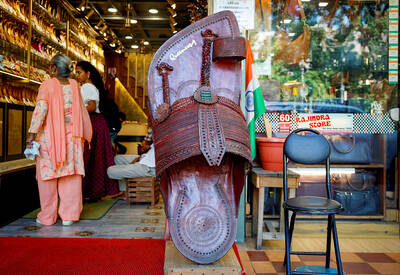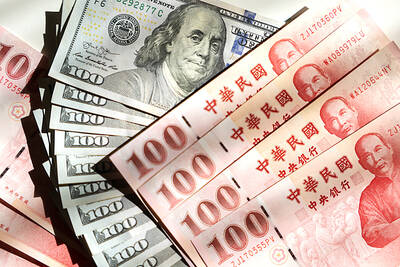Amid the turmoil of the Parmalat scandal and the debate over whether Prime Minister Silvio Berlusconi is "more equal" before the law than others, a small but significant bit of news slipped out.
Italians no longer wear vests. The government has officially consigned the classic, white sleeveless garment to the national dustbin.
Istat, the government statistics office, has informed the country that the humble vest, for decades a symbol of Italy's sweating and toiling working class, has been demoted from the national shopping basket, a list of staples used to calculate inflation.
With hazelnuts, upholstery fabric, silver spoons and miniature cars, the "canottiera," the government decided, was "in decline."
Instead, Italians are spending their money on cars, satellite dishes, exotic holidays and mopeds.
Of all the avalanche of annual state-of-the-nation information that has bombarded Italians this January -- record divorce rates, increasingly obese children, rising anti-Semitism -- the demise of the vest has touched a sentimental chord.
"Addio," said the Corriere della Sera's Gian Antonio Stella, in a piece entitled Sunset of the vest. "Will we ever forget them?"
"It's the end of an era," he wrote, adding that as the "land of the mamma" progressed, leaving the securities of the past behind, it was bound eventually to reject "maternal advice" on how to keep warm.
"The announcement surprised people, nevertheless, triggering a sort of dismay," Stella wrote.
For more than a century, the vest has been the symbol of Italy's honest, hard-working class, representing both poverty and physical strength. On holiday, the vest became working-class beach uniform, covering up pasta-filled paunches and providing perfect protection from the sun.
Since the vest was invented in the nineteenth century, film stars have made it a symbol of virility and politicians have attempted to harness its powerful populist symbolism. Benito Mussolini used the vest as a sign of earthy strength and virility.
But 60 years after the war, Italy is a consumer society and the demise of the humble piece of underwear is seen as confirmation that Italy is now officially rich.
"Vests are a sign of the poverty in Italy's past," said Maria di Salvia Baldini, author of a dictionary of clothes called The ABC of Elegance. "They are not just out of date, they have become a bit of an embarrassment. If a man absolutely has to buy a vest these days, he'll call it a `health T-shirt' instead."

MARKET LEADERSHIP: Investors are flocking to Nvidia, drawn by the company’s long-term fundamntals, dominant position in the AI sector, and pricing and margin power Two years after Nvidia Corp made history by becoming the first chipmaker to achieve a US$1 trillion market capitalization, an even more remarkable milestone is within its grasp: becoming the first company to reach US$4 trillion. After the emergence of China’s DeepSeek (深度求索) sent the stock plunging earlier this year and stoked concerns that outlays on artificial intelligence (AI) infrastructure were set to slow, Nvidia shares have rallied back to a record. The company’s biggest customers remain full steam ahead on spending, much of which is flowing to its computing systems. Microsoft Corp, Meta Platforms Inc, Amazon.com Inc and Alphabet Inc are

Luxury fashion powerhouse Prada SpA has acknowledged the ancient Indian roots of its new sandal design after the debut of the open-toe footwear sparked a furor among Indian artisans and politicians thousands of miles from the catwalk in Italy. Images from Prada’s fashion show in Milan last weekend showed models wearing leather sandals with a braided design that resembled handmade Kolhapuri slippers with designs dating back to the 12th century. A wave of criticism in the media and from lawmakers followed over the Italian brand’s lack of public acknowledgement of the Indian sandal design, which is named after a city in the

The US overtaking China as Taiwan’s top export destination could boost industrial development and wage growth, given the US is a high-income economy, an economist said yesterday. However, Taiwan still needs to diversify its export markets due to the unpredictability of US President Donald Trump’s administration, said Chiou Jiunn-rong (邱俊榮), an economics professor at National Central University. Taiwan’s exports soared to a record US$51.74 billion last month, driven by strong demand for artificial intelligence (AI) products and continued orders, with information and communication technology (ICT) and audio/video products leading all sectors. The US reclaimed its position as Taiwan’s top export market, accounting for

INVESTOR RESILIENCE? An analyst said that despite near-term pressures, foreign investors tend to view NT dollar strength as a positive signal for valuation multiples Morgan Stanley has flagged a potential 10 percent revenue decline for Taiwan’s tech hardware sector this year, as a sharp appreciation of the New Taiwan dollar begins to dent the earnings power of major exporters. In what appears to be the first such warning from a major foreign brokerage, the US investment bank said the currency’s strength — fueled by foreign capital inflows and expectations of US interest rate cuts — is compressing profit margins for manufacturers with heavy exposure to US dollar-denominated revenues. The local currency has surged about 10 percent against the greenback over the past quarter and yesterday breached